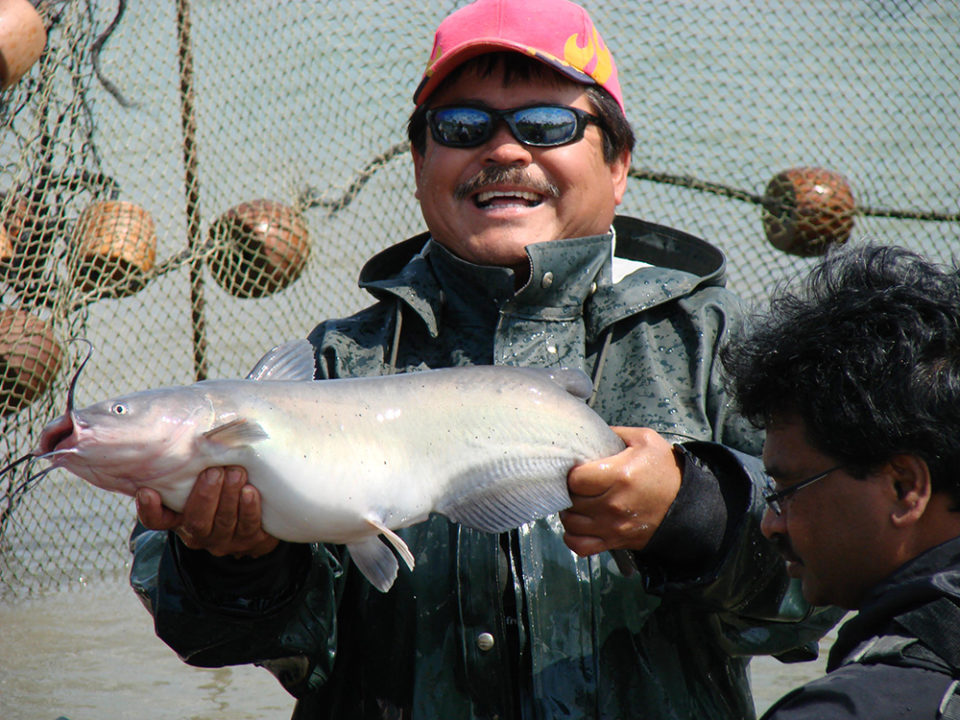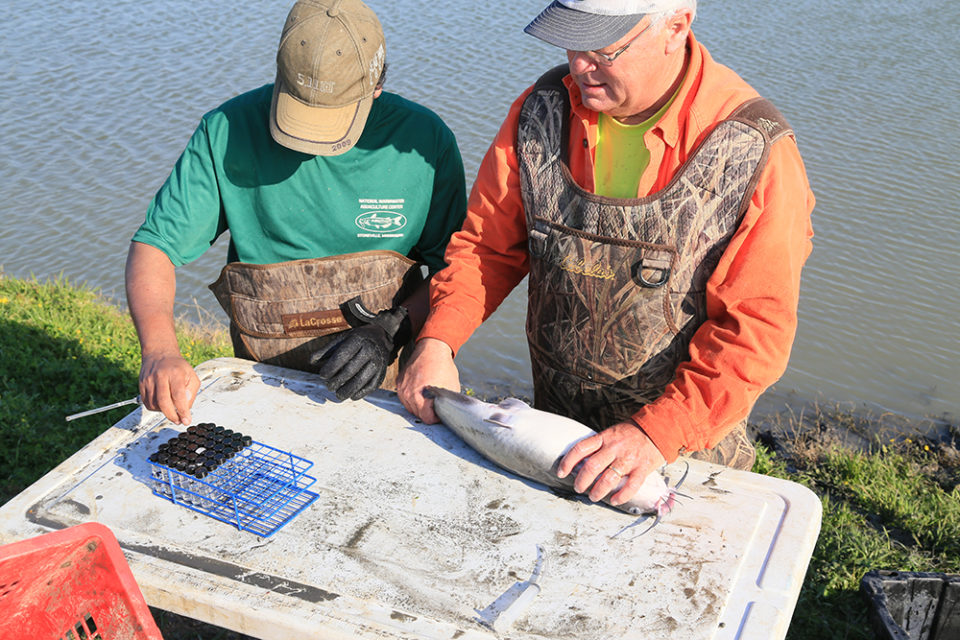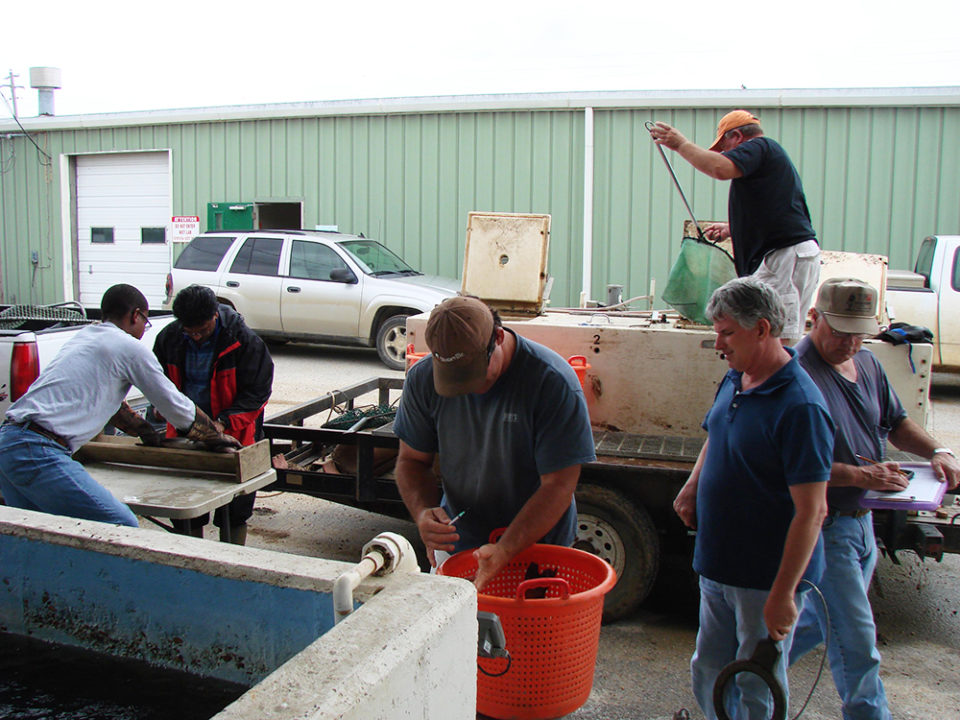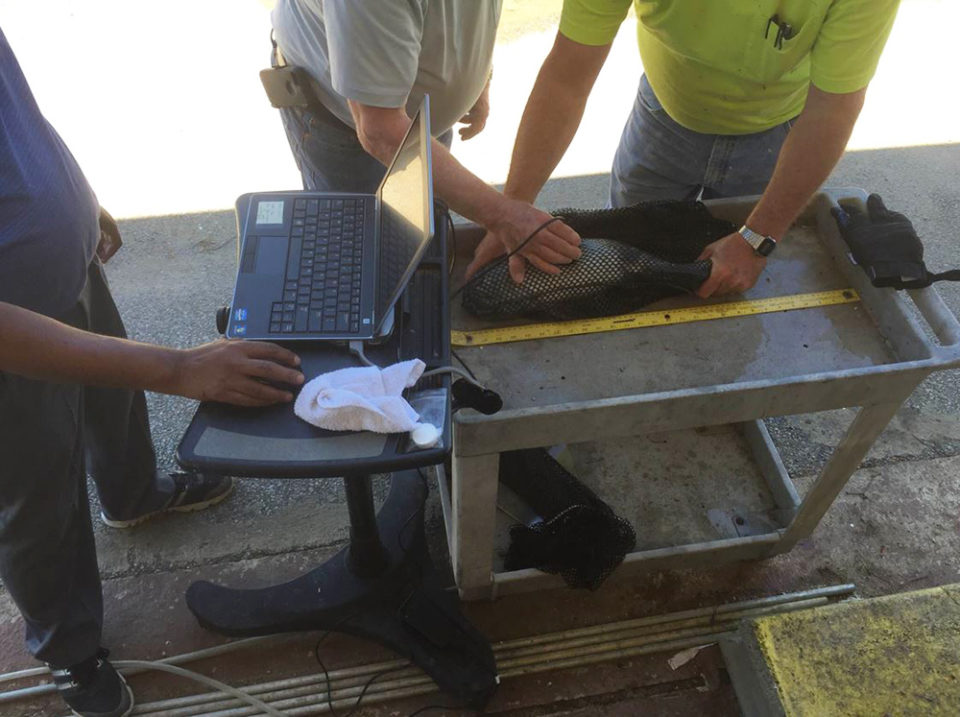Rapid, non-invasive method can improve hatchery efficiency

Most fish do not reproduce readily under captive conditions because environmental conditions necessary for reproduction are not well understood. To overcome spawning difficulties under aquaculture conditions, hormones often are administered to gravid female fish to induce and synchronize final oocyte maturation and egg release. A key to successful hormone induction of spawning is identifying fully mature, gravid females.
For more than 50 years, catfish farming in the United States relied on channel catfish produced through voluntary spawning in ponds. In the last 10 years, hybrids of the female channel catfish and male blue catfish became the dominant catfish used in catfish farming because of its superior growth rate, survival, tolerance to stressors, processing meat yield and resistance to common diseases. Producing hybrid catfish requires hormone-induced ovulation of gravid channel catfish females, manual stripping of eggs and fertilizing the eggs with a blue catfish sperm solution, followed by egg incubation in the hatchery.

Gonadal maturity in catfish
Gonadal maturity varies within the same cohort of catfish. Female channel catfish with superior or advanced maturity need to be identified and staged to result in successful fry production from strip spawning. Maturation is not synchronized in catfish; hence fish are handled more frequently to determine the stage of maturity and select fish of appropriate maturation for hormone induction.
Repeated handling of mature fish is laborious, and often result in stress, injury, disease, reduced performance and mortalities. Rapid, non-invasive methods to objectively stage maturation in catfish do not presently exist. Generally, catfish are subjectively staged (1 to 5 scale) individually by visual observations of secondary sexual characteristics and fullness of the belly. These five subjective stages of catfish maturity, based on secondary sexual characteristics and abdominal fullness, are as follows:
Stage 1. Flat abdomen, light red coloration with a small genital opening
Stage 2. Slightly fuller abdomen, light red coloration with a smaller genital opening
Stage 3. Smaller but fuller abdomen with palpation, pink color and a smaller genital opening
Stage 4. Large abdomen, firm on palpation, pink color and a smaller genital opening
Stage 5. Fully distended and soft abdomen on palpation, pink color with a protruding, large genital opening

Maturity in general is determined by gonadosomatic index, profiling oocyte size, position of gonadal vesicle in oocyte, histology of ovarian sections, plasma concentrations of steroid hormones and ultrasound imaging of ovaries. These methods are either subjective methods or time consuming, invasive and unreliable methods for practical application.
Testing portable NIR spectrometer
Although the efficiency of producing hybrid fry has dramatically improved over time, results remain inconsistent – mainly due to problems associated with identifying appropriate fish for hormone injection. The most popular current method involves subjective scoring of individual fish by visual observation of secondary sexual characteristics and fullness of the belly.
Methods that are quick, reliable and non-invasive to stage catfish maturity are needed. Therefore, in our study we evaluated the feasibility of microNIR spectrometers to objectively determine the stage of maturity in channel catfish.
Near-infrared spectroscopy (NIRS) is a technique that uses selective absorbance of long-wavelength light to identify different organic compounds. NIRS is used, for example, to assess meat and fish fillet quality based on differences in protein and fat content and composition. We therefore initiated studies to see if NIRS can be used to determine the stage of maturity in channel catfish.
The Onsite microNIR Spectrometer has a 900 to 1,650 nm spectral range, ~6 mm resolution, 2 mm x 4 mm sampling area, 100 scans per measurement, and five-second instrument analysis time per measurement, and weighs 200 grams. This instrument is integrated with the light source, spectrometer engine and electronics in a water proof case for routine field applications.
Dramatic biochemical changes occur in all fish during sexual maturation and spawning, as nutrients are mobilized to provide energy and resources needed for egg development and spawning. If those biochemical changes can be identified and measured, it may be possible to objectively identify fully mature female catfish suitable for hormone-induced spawning.

Channel catfish of varying stages of maturity were held in individual soft-mesh bags. Four abdominal scans per fish were obtained with a hand-held portable Viavi microNIR spectrometer. Each scan required about 5 seconds to complete. The complex spectrum of reflected light was recorded and the data was mathematically manipulated to develop a model from the spectral data that was highly correlated to visual scores of sexual maturity. The 31 females that were scanned had visual scores ranging from 3 to 5 (5 being “most gravid”) and the model using NIR spectral data ranked the fish, on average, as having corresponding scores of 3.25, 4.25 and 4.75, respectively (Table 1).
Chatakondi, NIRS, Table 1
| Catfish maturity (subjective stage) | Fish (#) | NIR range | Average NIR rank |
|---|---|---|---|
| 3 | 9 | 3.00 – 4.00 | 3.25 |
| 4 | 10 | 4.00 – 5.00 | 4.25 |
| 5 | 12 | 4.00 – 5.00 | 4.75 |
This preliminary study showed that microNIR spectra varied according to female sexual maturity and that it was possible to use that variation in NIR data to develop a model that correlated well with female maturity that was visually assessed. The next step will be to use the two methods to assess sexual maturity and see which method most accurately predicts egg production, egg hatching rate, and fry survival.
Perspectives
The portable microNIR spectrometer used to assess female catfish maturity is non-invasive, rapid, simple and repeatable. The instrument is rugged and has an ergonomic design suitable for field application. Although it is relatively expensive (about US$20,000), it may be possible for several farmers to share the instrument and reduce cost. Further research will show if this provides a rapid, non-invasive way to measure maturity in channel catfish that overcomes the issues with the subjective methods that are currently used.
Note: Mention of trade names or commercial products in this publication is solely to provide specific information and does not imply recommendation or endorsement by the U.S. Department of Agriculture.
Authors
-
Nagaraj G. Chatakondi, Ph.D.
Research Geneticist
USDA Agricultural Research Service (ARS)
Warmwater Aquaculture Research Unit
141 Experiment Station Road
P.O. Box 38, Stoneville MS 38776 USA
[118,111,103,46,97,100,115,117,46,115,114,97,64,105,100,110,111,107,97,116,97,104,99,46,106,97,114,97,103,97,110]
-
James E Rodgers, Ph.D.
USDA Agricultural Research Service (ARS)
Southern Regional Research Center
1100 Robert E. Lee Blvd.
New Orleans, LA 70124 USA
Tagged With
Related Posts

Health & Welfare
Egg saprolegniasis in a commercial sunshine bass hatchery
Fungal growth on the eggs caused by the water mold Saprolegnia spp. is an obstacle to the larval production of sunshine bass. This study confirmed that copper sulfate can be an economical and valuable resource in hatchery management for the control of saprolegniasis on sunshine bass eggs in McDonald jars.

Innovation & Investment
Artemia, the ‘magic powder’ fueling a multi-billion-dollar industry
Artemia, microscopic brine shrimp used as feed in hatcheries, are the unsung heroes of aquaculture. Experts say artemia is still inspiring innovation more than 50 years after initial commercialization. These creatures are much more than Sea-Monkeys.

Health & Welfare
Virulent Aeromonas hydrophila in channel catfish
This study investigated factors that predisposed catfish to motile Aeromonas septicemia (MAS) caused by virulent Aeromonas hydrophila (vAh). Results revealed that wounding on fish body surface was important for vAh infection and disease development.

Innovation & Investment
Caribbean producer aims to make a name for sutchi
Pangasius farmed in the Dominican Republic? True story. Value Aquaculture, with partners hailing from Germany and Chile, is trying to get U.S. buyers to take a fresh look at the Mekong catfish species.


